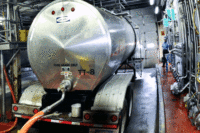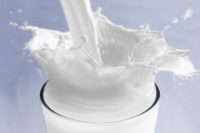Following are excerpts from the U.S. Department of Agriculture's Dairy Market News for the week ended Jan. 17, 2014. Download and read the complete report.
Milk production across the nation is trending higher along the seasonal trend, according to the USDA's Dairy Market News report for the week ended Jan. 17. Improved weather conditions in most regions of the country have been beneficial to milk production, especially in the Upper Midwest and Northeast, where temperatures have returned towards their seasonal norms.
Bottling demand has improved across most of the nation. Manufacturing plants nationwide are handling intakes without major delays. Overall cream demand has increased nationwide with improved Class II demand and with butter makers willing to handle additional supplies.
In the East: Manufacturing milk supplies declined this week in the Mid-Atlantic region as increased Class I demand reduced milk volumes going to balancing plants. Northeastern manufacturing milk volumes remained fairly heavy. Class I demand is strong in Florida with increased milk volumes being channeled to bottling plants as school and university consumption increases.
In the Midwest: Milk production rates in the Central region are coming back as feed quality and temperatures have improved, however, the growth has not been as big as expected for the current time for most areas. Interest remains for spot loads, but buyers are not willing to pay much more than $1.50 over Class. The milk supplies have not been as loose as years past at this point. A few processing plants were sending supplies to balancing plants. Some loads were delayed due to heavy snow in the northern part of the region on Tuesday. Bottling demand is very good with larger orders and good sales.
In the West: Weather across the southwest is comfortable and beneficial to milk production. Temperatures vary from the 20’s to the 60’s, with low humidity. Farm milk production in California is trending steady to higher. A few processors report recent upticks in milk intakes surpassed expectations formulated at the end of 2013. Manufacturing plants are handling intakes comfortably. Dairy producers are still facing financial challenges in handling upcoming operating costs.
Milk production in the Pacific Northwest is increasing along seasonally expected volumes. Moderate winter temperatures and lower feed costs are helping to increase production in the region. No major problems have been reported in moving milk to various manufacturing plants. Lack of significant snowfall is becoming more of a concern as reservoirs are at reduced levels for this year’s irrigation needs.
CHEESE HIGHLIGHTS: Cheese production levels continued to be mixed this week. Increased milk supplies are available for cheese makers. Manufacturers’ responses to the additional milk are varied. Sharply higher prices are enticing some processors to raise production, while others worry about higher priced inventories. Super Bowl orders are often the last big push for retail cheese demand for the holiday season. Good export orders for the first quarter of 2014 are helping to clear inventories. Cheese prices at the CME Group this week are higher with barrels up 4.25 cents from last Friday and blocks 3 cents higher from last week’s close.



